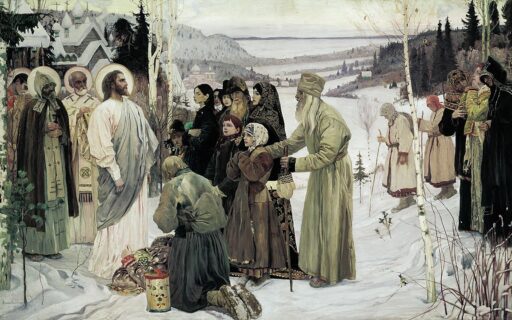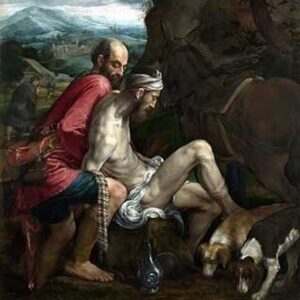One of the signal aspects of modernity for many intellectuals and artists is consciousness of history. The word modern comes from Latin meaning right now. Moderns are preoccupied with themselves, with their own moment. But that now, to be a radically distinct epoch whether for good or ill, must be cut off from the past. And so indeed we are. As moderns, we have problems with tradition—continuity with the past—and we have a fraught relationship with the kind of knowledge we call history.
By contrast, to the medieval mind the now which would later be hopelessly (or triumphantly, depending on your point of view) distinct from the past was so seamlessly continuous with it as to be indistinguishable. The medieval now included past and future, for the medieval mind thought in terms of universals, typologically and organically, and, as far as humanly possible, from the divine (i.e., transcendent) point of view. Not only the beginning and end of history (or, more accurately, of creation) but also its center was already known to the medieval: Christ, the eternal contemporary.
The Ukrainian-Russian writer Eugene Vodolazkin, an Orthodox Christian and professional medievalist, is preoccupied by history. There has been no dearth of historical fiction. Beginning with Romantics like Sir Walter Scott (though a theoretical basis for historical fiction goes back at least to the Renaissance master Torquato Tasso), modern fiction has been shaped by historical settings. This makes sense if, as I suggest, it is only by looking to the past that one can isolate the present, either to extol its excitement and opportunity or, as is the case with much of the best literature of the modern period, to react against it and its symptoms of geographical deracination, social atomization, and the breakdown of cultural traditions rooted in a sense of the sacred. (The best novels embody both these attitudes.)
A History of the Island (Plough Books) is Vodolazkin’s latest novel to be translated into English and the most overtly concerned with the idea of history. I’m not sure I would describe any of Vodolazkin’s work as historical fiction. I would call it revisionary, allegorical, and neomedieval. Italo Calvino might be the nearest cousin to Vodolazkin. Kazuo Ishiguro’s The Buried Giant, a quasi-allegorical tale of Britian, present and past, might be the nearest thing I’ve read to A History of the Island.
The main reason I say Vodolazkin’s books are not historical fiction is that they all arrive in, depart from, or visit the present at some point in the narrative. Properly speaking, historical fiction takes place entirely before the lifetime of the author. A History of the Island begins about 350 years before the present, in what is called the Middle Ages. It is an account, kept by a succession of monks, of a small realm called the Island. Some of the monks are men of startling vision and distinctive style, despite the role of mere chronicler. The record is organized according to the reigns of the monarchs or other leaders of the Island, in the Byzantine fashion.
Vodolazkin is fond of complex narrative strategies. There is nothing new about this—if anything, it is the archaic default method of fiction. His previous novel, Brisbane, comprised two narratives, one by the musician Gleb and one by a writer called Nestor who is working on Gleb’s biography. Both interspersed narratives move toward the present, Nestor’s from the beginning of Gleb’s life and Gleb’s from the onset of the illness that ends his career. Nestor, by the way, is the name of the monk to whom authorship of Russia’s Primary Chronicle is attributed. Names are not accidental for Vodolazkin but pregnant with symbolism and omen, as they are for the medieval writers he has spent his career studying. In this context I think as well of the four successive names of the eponymous character in Vodolazkin’s novel Laurus.
A History of the Island is likewise a composite narrative. The last King and Queen of the Island, Parfeny and Ksenia, provide laconic, digressive, retrospective commentary on the chronicle as it unfolds. This couple has lived almost 350 years. Parfeny and Ksenia are blasé about their longevity. Or perhaps I should say biblical. The monarchs are devout Christians acquainted with Scripture, where they find men and women whose lifespans were unusually long. As Ksenia concludes an early comment: “I used to feel shy about my age but that stopped after one hundred fifty. Some people simply live longer, for various reasons.” Their long life together in the story is arguably the only fantastical element in the story.
Parfeny and Ksenia would not pass muster as ‘good’ characters by the standards of contemporary realist fiction, but they are good in the old-fashioned sense of virtuous. In fact, they are the only good, self-sacrificing rulers of the Island. They are also the means by which the pathos of memory—the personal analogue of universal history—enters the world of the book. Because they live so long, Parfeny and Ksenia become stoic about government and their eventual displacement from power. But they never grow accustomed to the passing of the generations.
I said earlier that the Island is described as medieval 350 years ago, making Parfeny and Ksenia relics of that age. The later seventeenth century was not the Middle Ages of western Europe. A History of the Island is a loosely allegorical account of the history of Rus, the people centered first on Kiev and later, after emancipation from the Golden Horde, further north. In the fiction, the Island is divided into northern and southern halves, comparable, one supposes, to Muscovy and the Kievan Rus. The chronicle spans from the conversion of the Island population to Eastern Christianity through communist dictatorship to the ambiguous, wounded present. In the eastern marches of Europe, the medieval period persisted until the reign of Peter the Great in the late seventeenth century.
The penultimate entry of the chronicle, which records a cataclysm on the Island (but one which does not turn out to be total, as feared), is dated May 29th. No other entries are given specific dates. May 29th was the date of the Fall of Constantinople, center of Eastern Christianity and source of the conversion of the Rus. The last entry is dated October 16th. I find no significance to this specific date, but October is the month of the Bolshevik Revolution. The suggestion is maybe that the Island—allegorically the eastern Slavic peoples—is on the verge of a new revolution, perhaps verging into what Vodolazkin in a less tragic year called a “New Middle Ages.”
Vodolazkin is a modern like the rest of us—to be deep in history (if I may riff on Cardinal Newman, who was very interested in history) is to be a modern. But he can at least show us what a renewed medieval perspective might look like. The novel’s final chronicler chooses to interpret Parfeny and Ksenia’s final act not in a naturalistic, modern way but in a medieval way. Though it may be unconvincing philosophically to some readers, the book is a formal success because of its narrative strategy: the monk’s chronicle, able to reveal meaning where modern scientific history cannot.
Image: Holy Rus by the Russian painter Mikhail Nesterov, 1901-1906
Jonathan Geltner lives in Ann Arbor MI with his wife and two sons. His translation of Paul Claudel’s Five Great Odes is available from Angelico Press and a novel, Absolute Music, is available from Slant. If you enjoy his posts at Close Reading, check out his new Substack, Romance and Apocalypse, for more frequent and in-depth essays on the places where literature and other arts meet religious ideas and experience.





